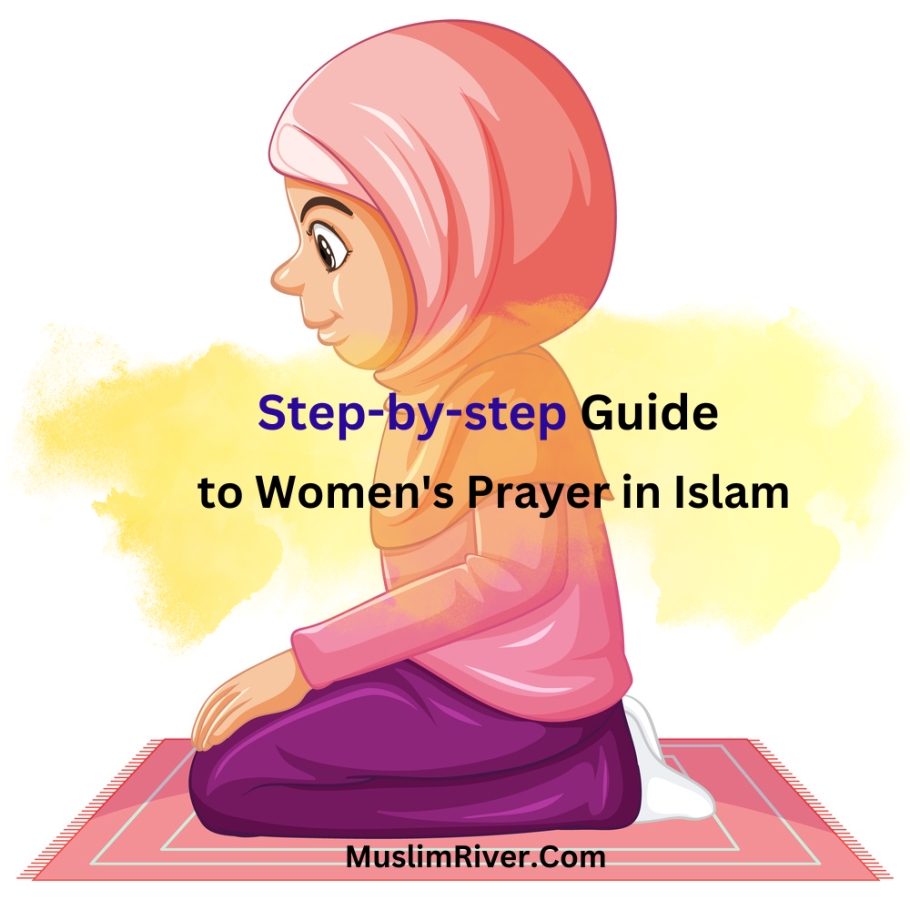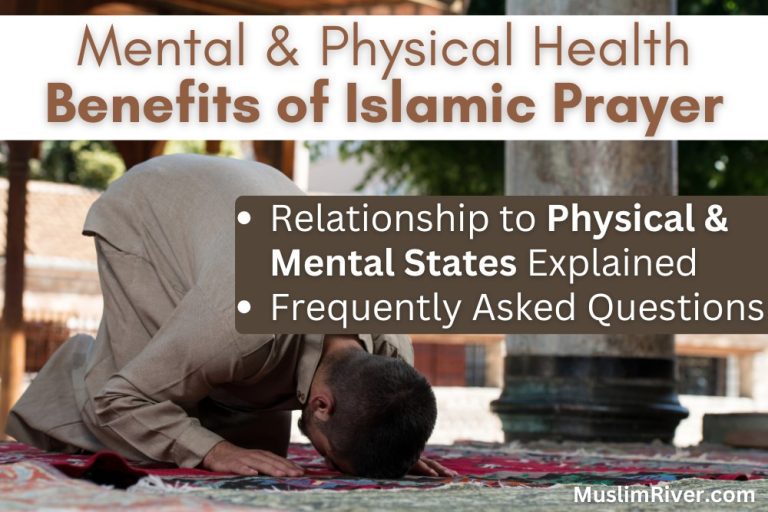How Do Muslim Women Pray?
As a Muslim, prayer or salah is an important part of your faith. Praying 5 times each day is one of the Five Pillars of Islam and it helps to keep you connected to Allah (SWT). But if you’re unsure how to pray, don’t worry – we are here to help.
Muslim women pray similarly to Muslim men, but there are 2 specific requirements (Dress code & Manner) specific to women in Islam, described in this article below.
This article is to help you understand the 5 requirements & 7 steps of prayer in light of the Quran and Sunnah of how Muslim women pray.

5 Requirements for Muslim Women’s Prayer
In order to pray properly and for your prayer to be valid, there are some requirements that must be fulfilled by men and women. For women, these requirements include:
1. Ablution
Before beginning your prayer, you must ensure your entire body is clean by doing wudu (ablution) or ghusl (Bath).
“’Allah does not accept any prayer without purification”
Source: Sunan Ibn Majah 273 – The Book of Purification and its Sunnah – كتاب الطهارة وسننها – Sunnah.com – Sayings and Teachings of Prophet Muhammad (صلى الله عليه و سلم
[Sunan Ibn Majah 273, Book 1, Hadith 7]
For ablution, men and women are required to follow the following steps:
- Make the Intention of doing Wudu(Ablution).
- Saying, Bismillah(In the Name of Allah).
- Washing Hands.
- Rinsing mouth & nose.
- Washing your face till your earlobes.
- Arms till elbow.
- Masah: Run the wet hands over your head.
- Feet till your ankles.
Izaalat-un-Najaasah: Izaalat-un-Najaasah is one of the important aspects of Muslim prayers. Izaalat-un-Najaasah refers to removing filth from one’s body, clothes, and place of prayer.
Note: Make sure water touches every inch of the body parts mentioned above. Also, Prophet (Peace be upon him) has prescribed washing the right side first.
2. Dress Code
Prayer dress for Muslim men and women requires them to cover their “Awrah” (Intimate body parts).
For women’s prayer, the dress code or Awrah requires one to cover one’s self from head to feet so that everything else is covered in loose clean garments except her face and hands.
A’isha reported God’s Messenger as saying:
“The prayer of a woman who has reached puberty is not accepted unless she is wearing a veil.”
Source: Mishkat al-Masabih 762 – Prayer – كتاب الصلاة – Sunnah.com – Sayings and Teachings of Prophet Muhammad (صلى الله عليه و سلم)
[Mishkat al-Masabih Book 4, Hadith 190]
3. Location
Regarding the location of prayer, Muslim women are expected to pray in a quiet place where they can be alone (While praying at home) and undisturbed.
The area should also preferably be clean. Additionally, you need to be facing the Qibla – when resting in prostration.
4. Manner
When praying, both men and women should be humble and pray with concentration.
“And seek help through patience and prayer, and indeed, it is difficult except for the humble”
Source: Tafsir Surah Al-Baqarah – 45 – Quran.com
[Surah Al-Baqarah, Verse 2:45]
Some important points for women & Islamic prayer:
- If going outside or to Masjid(Mosque) for prayers, women should go out fully covered, not wear strong perfume, and pray behind the men or in a designated prayer area for women.
- In congregational prayer, women should stand behind Muslim men orderly.
- While praying alone at home, women should cover themselves properly, and they should prefer to pray in their private space, which is clean and quiet.
Narrated Abu Usayd al-Ansari:
“Abu Usayd heard the Messenger of Allah (ﷺ) say when he was coming out of the mosque, and men and women were mingled in the road:
Source: Sunan Abi Dawud 5272 – General Behavior (Kitab Al-Adab) – كتاب الأدب – Sunnah.com – Sayings and Teachings of Prophet Muhammad (صلى الله عليه و سلم)
Draw back, for you must not walk in the middle of the road; keep to the sides of the road.
Then women were keeping so close to the wall that their garments were rubbing against it.”
[Sunan Abi Dawud 5272]
“Ibn ‘Umar reported the Messenger of Allah (ﷺ) as saying; Do not prevent your women from visiting the mosque; but their houses are better for them (for praying).”
Source: Sunan Abi Dawud 567 – Prayer (Kitab Al-Salat) – كتاب الصلاة – Sunnah.com – Sayings and Teachings of Prophet Muhammad (صلى الله عليه و سلم)
[Sunan Abi Dawud, Book 2, Hadith 177]
An intoxicated person’s “Salaah” won’t be valid until the effect of alcohol wears off.
5. Time
The timing of prayers (Namaz) is a very important aspect. Muslims must perform the five daily prayers at specified times throughout the day, regardless of location.
New Muslims can search for prayer timetables according to their location easily online.
Prayer timing for each prayer is:
- Fajr (prayed at dawn)
- Dhuhr (prayed at midday)
- Asr (prayed in the afternoon)
- Maghrib (prayed at sunset)
- Isha (prayed at night)
It is narrated on the authority of Abdullah the Prophet Muhammad (SAW) said:
“The best of’ the deeds or deed is the (observance of) prayer at its proper time and kindness to the parents.”
Source: Sahih Muslim 85e – The Book of Faith – كتاب الإيمان – Sunnah.com – Sayings and Teachings of Prophet Muhammad (صلى الله عليه و سلم)
[Sahih Muslim, Book 1. Hadith 162]
Also, Narrated by Abdullah:
“I heard the Prophet (ﷺ) forbidding the offering of prayers at the time of sunrise and sunset.”
Souce: Sahih al-Bukhari 1629 – Hajj (Pilgrimage) – كتاب الحج – Sunnah.com – Sayings and Teachings of Prophet Muhammad (صلى الله عليه و سلم)
[Sahih al-Bukhari, Book 25, Hadith 113]
Obligatory Steps of Salah (Prayer)
Muslims perform certain obligatory steps during each prayer, known as salah. Without following those steps, your prayer would either be considered invalid or faulty. The obligatory steps of the prayer include:
Niyah-Intention
For both men and women, the first step of each prayer right “Niyah” intention. Here intention means profound awareness of your actions and for whom you are doing them.
So stay mindful of the prayers you are reciting—Maghrib, Isha Zuhar, etc. And make sure they are always dedicated to Allah Almighty alone.
Takbeer
The opening Takbeer is one of the pillars or essential parts of the prayer, without which a person’s prayer is invalid, and he has not entered the prayer if he does not say it.
Standing upright and reciting “Allahu Akbar” ‘God is most great’, bowing down and reciting “Subhana Rabiyal Azeem” ‘Glory be to God Most’.
Prophet (peace and blessings of Allaah be upon him) said:
“The key to prayer is purification, its opening is to say “Allaah-u-Akbar” and its closing is to say “al-salaamu’ Alaykum.” Narrated by Ahmad
Source: Whoever omits the opening takbeer, his prayer does not count – Islam Question & Answer
[Abu Dawood, 618]
Qiyam
Most of the reciting of the Quran that occurs during Islamic prayer is done while in “Qiyam”. The first chapter of the Quran, Al-Fatiha, is recited while standing.
Additionally, recitations from any other section of the Quran of choice are followed in the first and second “raka’ah“.
Ruku
After concluding “Qiyam”, you will bow at the waist while standing, this is known as “ruku”. performed. “Ruku” includes recitation of glorification of Allah (سُبْحَانَ رَبِّيَ الْعَظِيم subḥāna rabbiya l-ʿaẓīm, “Glory be to my Lord, the Most Magnificent!”) in an odd number of times.
Sujood
“Sujood” is the prostration in the direction of “Qiblah” (Kaaba at Mecca). After “ruku”, in “Sujood,” you will kneel and bow till you touch the ground with the forehead, nose, palms, knees and toes and remain in that position until you attain a relaxed state while glorifying Allah سُبْحَانَ رَبِّيَ الْأعْلَى “subḥāna rabbiya l-ʾaʿlā” “Glory be to my Lord, the Highest!” in an odd number of times.
In each “raka’ah“, you’ll prostrate twice while sitting in between(Jalsa) to pray “Arabic Dua, رَبِّ اغْفِـرْ لي” “Rabbighfir lee”, ‘My Lord forgive me’.
Tashahhud/ Qa’dah
The final step of each prayer is to sit in “Qa’dah”, also known as the “Tashahhud”. During this part, you bless and praise Prophet Muhammad (PBUH) while sitting on knees and facing “Qibla”.
The recitation includes saying “Tashahhud” followed by “Salawat” and then prescribed Arabic “Dua”(salutations).
Salaam
Salam is the concluding portion of the Muslim prayer (salat), where one recites السلام عليكم ورحمة الله “As-salāmu ʿalaikum wa-raḥmatu-llah” ‘Peace and blessings of God be unto you’ once while facing the right, and once while facing the left.
For more information regarding the number of “raak’ah” visit this link: Islamic Prayers
You might also want to read: Can You Pray in English in Islam?
Frequently Asked Questions
How many times do Muslim women pray?
Muslim women like men pray five times each day. These obligatory prayers include Fajr, Dhuhur, Asr, Maghrib, and Isha.
What do Muslim women do before praying?
Before beginning the prayer, Muslim women perform ablution (wudu). This involves washing up body parts such as the mouth, nose, hands, face, and feet with clean water.
When can a woman not pray in Islam?
Women are not allowed to pray during their menstrual period or after childbirth until they have taken a ritual bath (ghusl).
Conclusion
We hope this blog post has provided insight into the prayers that Muslim women must perform each day. Praying is not only a way to connect with Allah but also helps to instill discipline and peace into one’s life. With dedication and sincerity, your prayer will be accepted by Allah (SWT).
If you have any more questions or concerns, please drop your question in the comment section below.






